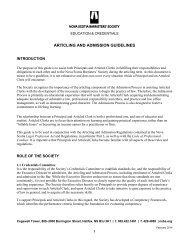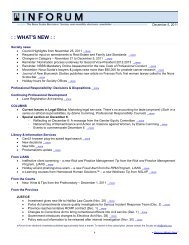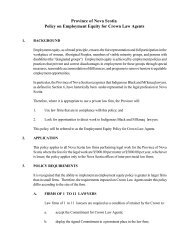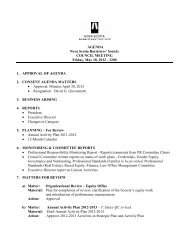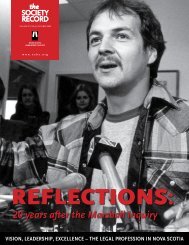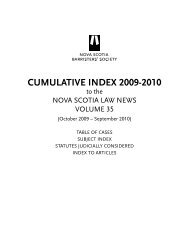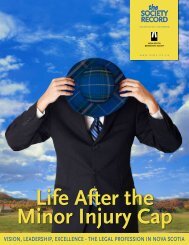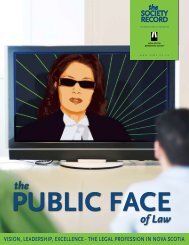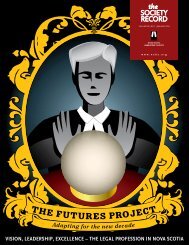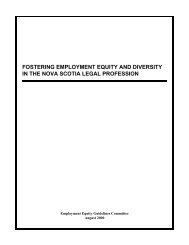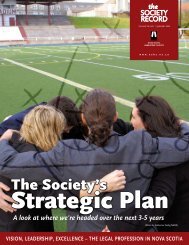SR Vol 25 No 1, January 2007 - Nova Scotia Barristers' Society
SR Vol 25 No 1, January 2007 - Nova Scotia Barristers' Society
SR Vol 25 No 1, January 2007 - Nova Scotia Barristers' Society
Create successful ePaper yourself
Turn your PDF publications into a flip-book with our unique Google optimized e-Paper software.
Bill <strong>No</strong>. 92, Act re Small Claims Court, was the final bill of theevening on May 21, 1980. There were but 15 members remainingin the chamber for discussion of the bill. Setting out theprinciple and object of the bill, Attorney General Harry How stated:The purpose of this court is stated in the preamble of the bill inthat I think all who have practised law and those who have perhapshad matters which they wanted to bring before the court,have oftentimes been frustrated by the fact that the costs of processingclaims through courts, of general use, has been consideredby some to be out of proportion at times, when the claimis small. Therefore, we come to the basis of this bill, it is a SmallClaims Court. (Hansard, 21 May 1980)He explained that the bill under discussion had been developedthrough consultations with consumer groups, the Law Reform AdvisoryCommittee, and input from the Barristers’ <strong>Society</strong>, who “werestrongly supportive of this legislation”.The Attorney General continued on to provide further details of a ratherunhappy and undesirable state of affairs in <strong>No</strong>va <strong>Scotia</strong>. He spokeof individuals “who had small claims and who were frustrated by thethought that they had no court.” He noted that for many years, backinto the 1960s and perhaps long before, “...that although there was aso-called municipal court available in the statutory sense, that in thepractical sense it was [not] available because there were really no judgesthat were prepared to sit in judgment in respect of that court.”There is no doubt that reform of the court structure was long overdo in1980, and the establishment of Small Claims Court was only one partof a rethinking and restructuring that would take place over the nextdecade or so. Significant reform took place following the Report of the<strong>No</strong>va <strong>Scotia</strong> Court Structure Task Force (March 1991), chaired by ProfessorBill Charles, Q.C. of Dalhousie Law School. In a brief history of the<strong>No</strong>va <strong>Scotia</strong> Courts, which appears as Appendix 1 of the Charles TaskForce, it was noted that complaints were heard from the Bar <strong>Society</strong> asfar back as 1913 about the multiple framework of Justices, StipendiaryMagistrates, Municipal, City, County and Supreme Courts. It isapparent that these complaints fell on unlistening ears for many years.Magistrates Court, established in <strong>No</strong>va <strong>Scotia</strong> in 1827, continued until1985. Municipal Court was in existence from 1888 to 1985.In discussion on the bill, one honourablemember took issue with thefact that the proposed legislationpermitted parties to be representedDavid BlaikieDalhousie Law Schoolby lawyers. The Consumers Association of Canada had recommendedthat lawyers be barred from Small Claims Court. David Muise,member for Cape Breton West, stated that:The Attorney General, in his opening remarks, said he hoped to simplifythe process and to make it informal, and I think that that thinkinghas been felled with one blow in Section 16 by saying that theperson may be represented by counsel. I disagree with that very strongly,although I am a lawyer. I feel that there is nothing that will muddy thewaters more or make it more formal than the presence in that systemof lawyers. I think that the system can be run very successfully and veryinformally without the use of lawyers.In a somewhat related critical vein, the honourable member from CapeBreton East, Jeremy Akerman, questioned the wisdom of section 6 (3)that requires small claims court adjudicators be “a practising memberin good standing of the <strong>No</strong>va <strong>Scotia</strong> Barristers’ <strong>Society</strong>.” He said thathe “had often thought that the introduction of more lay persons intothe judicial system would be no bad thing indeed.…” He praised as amodel to emulate, magistrates court in Australia, where the judges arelay persons, and explained, in part, as follows:You would not want, you know, and I say this with no disrespect tocoal miners or doctors, but you would not want a coal miner or doctorjudging a murder trial in which there were very complicated proceduresand some very complicated evidence, some tricky points of law. You justwould not want that to happen. But at other levels [such as a smallclaims court], it seems to me that we could involve more lay persons.Following a discussion and debate on these and several other concernsand questions, the bill passed second reading and was referred to theCommittee on Law Amendments, and eventually, of course, becamelaw. Most <strong>No</strong>va <strong>Scotia</strong>ns would agree, I think, that Small Claims Courthas addressed quite effectively the fundamental concerns and needsidentified in 1980, perhaps in part because of, or no doubt in the eyesof some, despite, the fact the legislation requires adjudicators to be lawyersand allows parties to be represented by legal counsel.<strong>January</strong> <strong>2007</strong> 27



